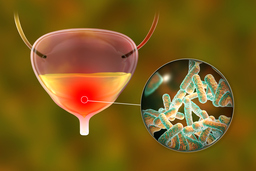An Indole Analysis Method and its Application for Detecting Bacterial Infection
TECHNOLOGY NUMBER: 2022-278

OVERVIEW
A novel indwelling urinary catheter that recognizes indole produced by E. coli- Incorporation of an agent that shows clinically relevant E. coli concentrations
- Permits visual confirmation of urinary tract infections with red coloring
BACKGROUND
Indwelling urinary catheters are medical implants commonly used in hospitals, nursing facilities, and homes to relieve urinary retention and incontinence. This device can be implanted for short-term use (< 4 weeks) or long-term use (1-3 months). One of the primary risks with indwelling catheters is the risk of infection, specifically catheter-associated urinary tract infections (CAUTIs). Symptoms of CAUTI can range from mild (urethritis, fever, and cystitis) to severe (renal scarring, acute pyelonephritis, calculus formation, and bacteremia). Without timely treatment, infections can lead to urosepsis and death.
CAUTI infections are most often caused by Escherichia coli (E. coli). Various methods have been developed for E. coli detection, including polymerase chain reaction (PCR), mass spectrometry, conventional culture methods, aptamer-based sensors, and immunoassays. However, these methods present considerable limitations such as multi-step incubation and preparation, complicated instruments to be operated by trained professionals, and in many cases, samples that must be sent away for testing. Inevitably, these approaches lead to a longer wait time to retrieve results and initiate treatment.
INNOVATION
Researchers report the development of a urinary catheter-based colorimetric sensor for on-body detection of Escherichia coli (E. coli), the most prevalent bacterial species in urinary tract infections associated with the use of urinary catheters. This novel indwelling catheter sensor recognizes indole, a characteristic metabolite produced by E. coli. While existing techniques utilize this approach in vitro to identify indole as a surrogate for the presence of E. coli, the current technology incorporates a nitrosating agent into a silicone catheter to provide a clinically relevant red color change to signify indole production, and therefore E. coli activity. This color change allows for early diagnosis of urinary tract infections using the naked eye by functionalizing an exposed section of urinary catheters with the molecular probe. This silicone-based colorimetric sensor clearly differentiates E. coli below and above 105 colony forming unites per milliliter, which is the threshold concentration of bacteriuria. The technology therefore has important implications for usefulness in clinical situations, and beyond.